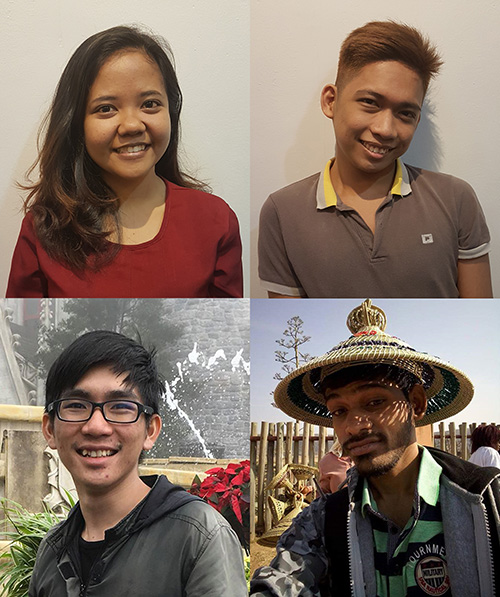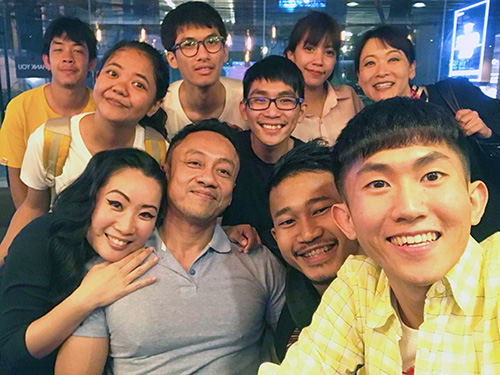TREAT Asia has been working with our partners to build capacity among young people in the region to advocate for better access to HIV prevention and treatment for themselves and their peers. Through our Youth ACATA leadership training program, the network of advocates is growing. They have begun participating in global youth programs, including SPARK17 and the Adolescent Treatment Coalition, so that Asian voices are heard. We asked some of them to reflect on where they think we need to do more to make youth-led advocacy a reality in our region.

(Clockwise, from top left) Ikka Noviyanti, John Fernand Clemente, Amit Mohite, and MikeQ
Ikka Noviyanti is the Advocacy and Capacity Development Officer at Youth LEAD in Bangkok. She previously worked with OPSI in Indonesia, a sex workers rights organization.
In this region there are many organizations that work for young people, but few let the young people lead and run their organization. As a result, young people may feel uncomfortable to be in these organizations or lack confidence to speak out. Then when young people have the chance to run organizations independently, we may lack the skills to know how to do this. Also, there are many young people who can speak and advocate around HIV issues, but when we have to speak in public or in front of government officials, we often face difficulties because of a lack of confidence or limited policy knowledge, or due to language barriers. Then we hesitate to share our opinions and may not be heard.
So I think the most important thing to strengthen youth-led HIV advocacy in the Asia-Pacific region is capacity building for young people. This includes providing us with accurate and up-to-date information about HIV, giving us space to express our opinions about issues like HIV services and program funding, and trusting us to start doing our own advocacy work. Even if we are strong leaders on our own, we need the support of established advocates and community organizations to help us to grow.
John Fernand Clemente has been living with HIV for almost four years and is a youth advocate working with Pinoy Plus and other NGOs in the Philippines. These includes the HIV/AIDS Support House, as a community-based HIV Screening Motivator; HIV Awareness Campaign Group—The Project Embrace, as one of the administrators; and the International Youth Council Pilipinas. His priority is to support young, key-affected populations.
In the last four years that I’ve been involved with HIV advocacy, I have worked with many youth HIV advocates in the Asia-Pacific region. They are hard-working, passionate in their advocacy, and they are survivors who have fought back for the hopeless.
The most important thing we can do to strengthen youth-led HIV advocacy in the Asia-Pacific region is to strengthen the capacity of every youth advocate and make this part of HIV advocacy promotion interventions. HIV youth advocates don’t always have the power to speak up or speak out to raise public awareness. Strengthening their capacity would give them opportunities to enhance their skills and abilities, which will contribute not only to their own career growth, but also help them to influence others to continue advocacy activities in the future. This is important because having a capacity-building program is an effective way to build new leaders in the community who can solve the difficult problems in our societies that impact young people. Capacity-building is a continuous process and is not just a one-time opportunity. I have seen youth HIV advocates who take these opportunities to grow and improve their advocacy potential, and then have a big impact on their communities.
Amit Mohite is a youth advocate in India supporting the Prayas Health Group in Pune and the Network of Maharashtra People Living with HIV. He also is a youth representative on the Community Advisory Board of the National AIDS Research Institute.
I have worked at a local HIV support group and interacted with many adolescents. After they are diagnosed with HIV, I have seen their negative attitude about life, unhappiness, dropping out of school, and their feeling that life is going to end soon so just enjoy it. I also lost many years in this trauma and isolation. I call our experience as this, “vicious circle.” But then I met a counsellor who showed by example how to live with HIV as an adolescent.
After an adolescent learns about their HIV status, they do not believe that they can still live a long life with HIV. A solution for this is that we need to give them proper peer counselling and connect them with support groups. But peer counsellors need to be trained in treatment literacy—not only about the importance of adherence, but also about how medicines work in the body.
In most of the Asia-Pacific region, there are large numbers of people living HIV who might have free HIV medication through their governments, but unfortunately they don’t have adequate counselling. If we want to strengthen advocacy in young people we need to provide them with peer counselling. We also need young people to be trained as counsellors for other young people.
Finally, we need to focus on their social growth because young people experience high levels of stigma and discrimination and it makes them not feel safe. With peer support and good counselling we can provide them with a safer environment.

Asia-Pacific youth advocates preparing for AIDS 2018 and youth advocacy activities with regional mentors
MikeQ is a youth advocate who co-founded the Thai Network of Youth Living with HIV (TNY+) to give Thai youth a platform to share their experiences about living with HIV and promote advocacy to improve the quality of HIV care delivery and reduce stigma in the country.
The first thing I believe we need to do to achieve successful youth-led advocacy in the region is to make sure that the team working on the advocacy activities is focused on the same direction and objectives. This includes seeing what kinds of issues are considered to be violations of youth rights. Next, I think we need to connect organizations that advocate for youth rights to policy makers who have the ability to make decisions to change our society. As for youth ourselves, we need to have advocacy teams that create social impact to improve basic human rights and promote equality (even if that impact starts in small communities).
Through these things, our society might be able to see the linkage between basic human rights advocacy and advocacy for youth living with HIV—they are deeply connected and efforts to improve one of these areas must include the other. In order to make this happen, we will need direct youth participation both in the policy area and in the field where community interventions need to be implemented.